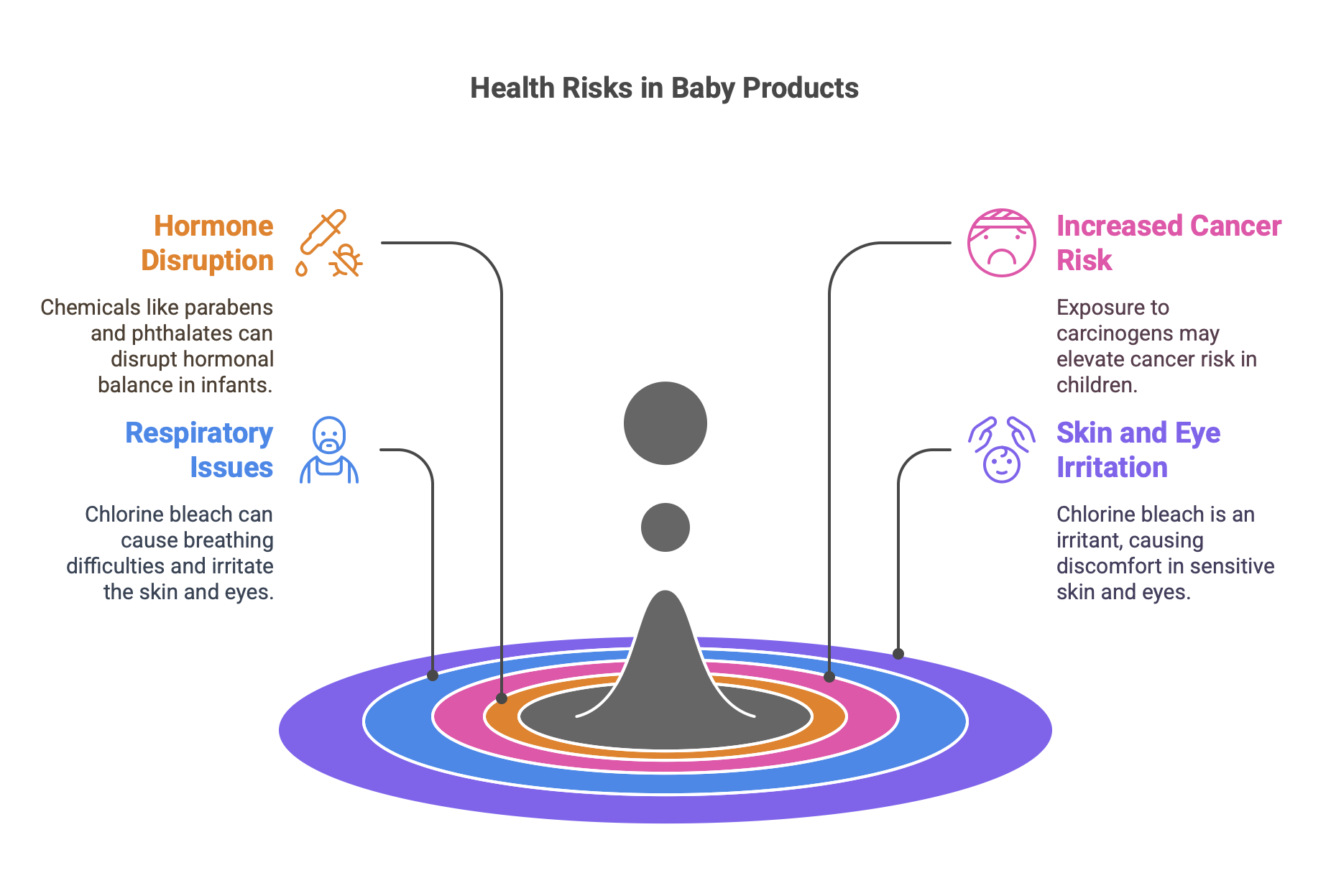TL;DR
Protecting Babies from Harmful Chemicals
Protecting babies from harmful chemicals in products is vital due to their heightened vulnerability to toxins and carcinogens. Common baby items, including sunscreens, often contain hazardous ingredients like parabens, phthalates, synthetic fragrances, and chlorine bleach, which can disrupt hormones and cause health issues. Non-toxic alternatives, especially in sunscreens, are essential for safeguarding children's health and development. Parents should proactively choose safe, chemical-free products to promote their baby's well-being.
Understanding Harmful Chemicals in Baby Sunscreen
Many baby sunscreens contain harmful chemicals like oxybenzone, octinoxate, homosalate, and octocrylene, linked to hormone disruption, metabolism interference, skin allergies, and increased chemical absorption into the bloodstream. Studies, including those published in JAMA, confirm these risks, highlighting the need for safer options. Concerns over benzene contamination further stress the importance of scrutinizing products. Parents are advised to choose physical sunscreens with zinc oxide or titanium dioxide, which provide UV protection without harmful chemical absorption. Prioritizing safe sunscreen options helps shield children from both UV damage and toxic exposures.
Regulatory Standards and Advocacy for Safer Baby Sunscreens
The FDA regulates baby sunscreens through stringent testing and labeling requirements to ensure SPF accuracy, broad-spectrum protection, and water resistance. Recent proposals aim to improve safety and effectiveness by updating rules on active ingredients, SPF limits, and labeling standards. A 2021 "deemed final order" outlines current OTC sunscreen marketing rules, while a proposed order suggests future updates. Advocacy efforts highlight risks from chemical ingredients like avobenzone, oxybenzone, and octocrylene, absorbed into the bloodstream. Only physical sunscreens with zinc oxide or titanium dioxide are deemed safe. The FDA remains committed to updating regulations to ensure public access to safe and effective sun protection.
Environmental Impacts of Baby Sunscreens on Coral Reefs and Aquatic Ecosystems
Coral reefs, vital for food, tourism, and coastal protection, are threatened by chemicals in baby sunscreens. Active ingredients in sunscreens, including UV filters, can harm aquatic life, contributing to ecosystem degradation. Regions like Hawaii and Palau have banned harmful sunscreens to protect marine environments. Research shows a complex relationship between sunscreen chemicals and marine ecosystems, with some findings suggesting lesser toxicity to small aquatic organisms than previously believed. Despite this, continued research and the promotion of eco-friendly sunscreen alternatives remain critical to safeguarding aquatic ecosystems and supporting marine biodiversity.
Health Impacts of Sunscreens on Infants: Short-Term and Long-Term Effects
For babies under six months, sunscreen use is generally discouraged due to risks of skin irritation, rashes, and allergic reactions caused by chemicals like oxybenzone and octocrylene. Infants' thinner skin absorbs substances more easily, increasing vulnerability. Pediatricians recommend physical sun protection like clothing and shade over chemical sunscreens. Long-term concerns include the absorption of sunscreen chemicals into the bloodstream, as shown in JAMA studies, necessitating further research. However, the FDA and pediatric experts emphasize the proven dangers of sunburns and UV exposure, urging balanced sun protection strategies for infants.
Endocrine Disruption: Risks from Baby Sunscreen Chemicals
Baby sunscreens and personal care products often contain endocrine disruptors like phthalates, which mimic or interfere with natural hormones. A study by George Mason University linked personal care product use to elevated phthalate levels in children, raising concerns about developmental risks. These chemicals can penetrate the skin, entering the bloodstream and causing hormonal imbalances that may lead to long-term health issues. Researchers emphasize the urgent need for stricter regulation and safer product formulations to protect children's hormonal development and overall health.
Background
Ensuring the safety of baby products is paramount for new parents, especially when
it comes to protecting their little ones from potentially harmful chemicals[1]. Babies
are particularly vulnerable to the effects of toxins and carcinogens. According to the
US Environmental Protection Agency, children are more susceptible to the effects of
carcinogens than adults, with chemicals that cause cancer through genetic mutations
being significantly more potent for children[4].
Common baby products, including sunscreens, often contain a variety of harmful
chemicals. Ingredients such as parabens, phthalates, and synthetic fragrances are
known to pose health risks, including hormone disruption and increased cancer
risk[1][2]. Chlorine bleach, another common chemical found in various baby products,
is linked to respiratory issues and is an irritant to the skin and eyes[2]. Furthermore,
benzene, a carcinogen, has been found in some sunscreen products, though many
non-toxic options are available that are free from such harmful chemicals[3].
It's crucial for parents to be aware of these risks and opt for products that avoid
these dangerous ingredients. The importance of choosing safe, non-toxic sunscreens
is underscored by the fact that many baby products and toys contain ingredients
that could be harmful to a child's health and development[4]. Taking proactive steps
to avoid endocrine disruptors and other harmful chemicals can help ensure the
well-being of both the baby and the parents[5].

ALVA Veriefied products ✅
When you make a purchase through retailer links on our site, we may earn commission through affiliate programs. All affiliate fees ALVA receives support our mission. Learn more here
Are your products safe?
Scan your products now with the ALVA app to get a personalised risk analysis.
Specific Harmful Chemicals and Their Effects
Several chemicals commonly found in baby sunscreens have raised concerns due
to their potential harmful effects on a baby’s developing body.
One of the most prominent chemicals is oxybenzone, which acts as an endocrine
disruptor and has been linked to hormone disruption[21]. Octinoxate, another com-
mon ingredient, can interfere with metabolism and thyroid hormones[21]. Homosalate
is known to penetrate the skin and may carry the risk of allowing other harmful
chemicals to enter the body[21]. Octocrylene has been associated with high rates
of skin allergies[21].
The absorption of these chemicals into the bloodstream has been confirmed by
studies, including one published in the Journal of the American Medical Association
(JAMA), which highlighted that levels of these chemicals were high enough to warrant
further research[8][23]. The U.S. Food and Drug Administration (FDA) continues
to recommend the use of sunscreen while additional studies are conducted, as
the immediate risks of sun exposure—such as sunburns, skin damage, and skin
cancers—are well-documented and severe[8][23].
Additionally, there are concerns regarding the presence of benzene, a known car-
cinogen, in some sunscreen products due to manufacturing errors[9]. This underlines
the importance of careful selection and scrutiny of sunscreen products for children.
Given these risks, it is recommended to use physical sunscreens containing zinc
oxide or titanium dioxide, as they are generally safer and work by reflecting UV rays
away from the skin rather than absorbing them[11]. This approach minimizes the
risk of chemical exposure while still providing effective protection against the harmful
effects of UV radiation.
Regulatory Standards and Advocacy
Current regulatory standards for baby sunscreens are established and enforced by
the U.S. Food and Drug Administration (FDA) to ensure their safety and efficacy
in protecting against harmful sun exposure. The FDA’s regulations include rigorous
testing requirements for Sun Protection Factor (SPF) levels, broad-spectrum protec-
tion against UVA and UVB rays, and water resistance claims[17]. Moreover, the FDA
mandates adherence to stringent labeling guidelines, making it easier for consumers
to identify key product information[13].
In 2019, the FDA proposed significant changes to sunscreen regulations to enhance
the quality, safety, and effectiveness of these products[15]. However, the finalization
of these new rules on chemical sunscreen labels is still pending as the agency
seeks additional information[15]. Among the proposed changes, the FDA has fo-
cused on updating requirements related to maximum SPF values, active ingredients,
broad-spectrum protection, and labeling[16].
A noteworthy step taken by the FDA includes the issuance of a deemed final order
and a proposed order for over-the-counter (OTC) sunscreen products on September
24, 2021. The deemed final order sets the current marketing requirements for OTC
sunscreens, while the proposed order suggests revisions to these requirements,
reflecting the FDA’s future regulatory vision[14]. These steps are part of the FDA’s
efforts to implement new authorities for certain OTC drugs, thereby improving the
overall quality, safety, and efficacy of sunscreens[16].
Recent advocacy efforts have emphasized the need for sunscreens that exclude
harmful chemicals. In 2019, the FDA conducted a pilot study which revealed that
four chemical sunscreen actives—avobenzone, oxybenzone, octocrylene, and ecam-
sule—are absorbed into the bloodstream when used as intended[15]. Currently, only
physical sunscreens with active ingredients such as zinc oxide or titanium dioxide
are recognized as generally safe[15].
The FDA continues to evaluate new scientific data and update its regulations ac-
cordingly to ensure that consumers have access to safe and effective sunscreen
products[17][18]. These efforts highlight the ongoing commitment to safeguarding
public health and providing reliable sun protection options.
Environmental Impacts
Healthy coral reefs are one of the most valuable ecosystems on Earth, providing
billions of dollars in economic and environmental services, such as food, coastal
protection, and tourism[25]. However, coral ecosystems worldwide face serious
threats from various sources, including harmful chemicals commonly found in baby
sunscreens. These sunscreens, which protect humans from cancer-causing ultravi-
olet rays, contain active ingredients that can be toxic to aquatic life in oceans, rivers,
and lakes[26].
Research has indicated that some ultraviolet filters (UVFs) in sunscreens are detri-
mental to coral reefs. As a result, regions like Hawaii and Palau have implemented
bans on certain types of sunscreen to mitigate these harmful effects[28]. A study
from the University of Alberta has provided new insights, showing that sunscreens
may be less toxic to small aquatic creatures than previously assumed, highlighting
the complexity of chemical interactions in marine environments[28].
Despite these findings, there remains an urgent need for more information to under-
stand the broad-scale impact of these chemicals on aquatic ecosystems[26]. The
potential environmental costs of these chemicals are significant, as they contribute
to the degradation of ecosystems that support a wide range of marine life[26]. To
protect these ecosystems, it is crucial to continue research and to promote the use
of safer alternatives in personal care products, including baby sunscreens[29].
Health Impacts on Infants
Short-term Effects on Baby’s Skin
The use of sunscreen on babies under 6 months old is generally not recommended
due to the potential adverse reactions associated with their delicate and sensi-
tive skin[31]. Sunscreen chemicals like oxybenzone, octinoxate, homosalate, and
octocrylene, commonly found in many products, can have short-term effects such
as skin irritation, rashes, and allergic reactions[33][34]. Infants’ skin is thinner and
absorbs substances more easily than older children and adults, which increases
the risk of these adverse effects[31]. Furthermore, oxybenzone is known to be
an endocrine disruptor, while octocrylene has been linked to high rates of skin
allergies[32]. Pediatricians and dermatologists advise using physical barriers, such
as clothing and shade, to protect infants from the sun’s harmful rays rather than
relying on chemical sunscreens[33][35].
Long-term Health Impacts
A study published in the Journal of the American Medical Association (JAMA) found
that chemicals in some sunscreens are absorbed into the bloodstream in levels
high enough to warrant additional research[30]. Pediatric dermatology providers at
Children’s Hospital of Philadelphia (CHOP) explain that while this data highlights a
need for further investigation of sunscreens, there are already very real proven health
risks associated with over-exposure to sunlight, such as sunburns, skin damage,
and skin cancers[30]. The Food and Drug Administration (FDA), which conducted
the study, specifically advises people to continue to use sunscreen while additional
research is done[30]. Therefore, it is essential for parents to be aware that although
the study suggests potential risks from sunscreen chemicals, the immediate health
risks from not using sunscreen are well-documented and substantial[30].
Endocrine Disruption
Endocrine disruptors present in baby sunscreens and other suncare products have
raised significant concerns among researchers and health professionals due to
their potential impact on hormonal development in infants. A study by the George
Mason University College of Public Health has demonstrated a worrying correlation
between the use of personal care products, including sunscreens, and elevated levels
of phthalates in young children[36][37]. Phthalates, which are commonly used to
enhance the flexibility and durability of plastics, are also found in various personal
care items such as lotions, hair oils, and conditioners[36][37].
These chemicals are known for their endocrine-disrupting qualities, meaning they
can mimic, inhibit, or interfere with the body’s natural hormones. Researchers are
particularly concerned about their potential effects on children’s development during
critical growth phases. The study led by Professor Michael S. Bloom involved 630
children aged four to eight across ten sites in the United States, highlighting the
widespread nature of the issue[37].
The mechanisms through which endocrine disruptors interfere with hormonal devel-
opment are linked to their ability to be absorbed through the skin, which is porous and
allows chemicals to enter the bloodstream and lymphatic system[38]. Once inside
the body, these substances can create hormonal imbalances by interacting with the
endocrine system, leading to potential long-term health issues[38]. The presence of
these chemicals in products designed for infants underscores the urgent need for
greater scrutiny and regulation to protect children’s health.
REFERENCES:
[1]: 29 Ingredients to Avoid in Baby Products | Puracy
[2]: Toxic Chemicals Commonly Found in Baby Products – Women’s Voices for …
[3]: The Best Non-Toxic Baby Sunscreens – Center for Environmental Health
[4]: 20 Ingredients to Always Avoid in Baby Products – Eco Pea Co
[5]: Avoiding harmful chemicals in baby products: advice for parents
[6]: The Most Toxic Products at Baby Stores – House Beautiful
[7]: The 14 Worst-Scoring Sunscreens for Babies and Kids
[8]: Is Sunscreen Safe? – Children’s Hospital of Philadelphia
[9]: 5 things to know about sunscreen, benzene and other chemicals
[10]: The Best Non-Toxic Baby Sunscreens – Center for Environmental Health
[11]: Are Sunscreen Products Safe? – Poison Control
[12]: Choosing Safe Ingredients in Baby Skin Care Products – Healthline
[13]: FDA advances new proposed regulation to make sure that sunscreens are …
[14]: Questions and Answers: sunscreen deemed final order and proposed order
[15]: FDA’s Proposed New Sunscreen Regulations & What They Mean
[16]: FDA Issues Deemed Final Order on Sunscreens | Skin Inc.
[17]: Navigating the FDA’s Regulatory Path for Sunscreen
[18]: FDA take aim at improving quality, safety, and efficacy of sunscreens
[19]: Chemical Exposure from Personal Care Products – American Academy of …
[20]: Protecting delicate skin from harmful UV radiation: Sun safety tips for …
[21]: How to deal with chemicals in sunscreen for babies and kids
[22]: Fact sheet: Sun protection and babies (0-12 months) – Cancer Council
[23]: Is Sunscreen Safe? – Children’s Hospital of Philadelphia
[24]: What To Know About Sunscreen for Babies – Cleveland Clinic Health …
[25]: Skincare Chemicals and Marine Life – NOAA’s National Ocean Service
[26]: Sunscreen Risks to Aquatic Life and Ocean Ecosystems
[27]: Sunscreen: Its effects on the environment and on you
[28]: Sunscreens may be less harmful to aquatic ecosystems than expected
[29]: Chemical Exposure from Personal Care Products – American Academy of …
[30]: Is Sunscreen Safe? – Children’s Hospital of Philadelphia
[31]: Is It Safe to Use Sunscreen on Babies?
[32]: How to deal with chemicals in sunscreen for babies and kids
[33]: Should You Put Sunscreen on Infants? Not Usually | FDA
[34]: Sun Safety 101: Protecting Your Children with Sunscreen
[35]: Sunscreen Smarts for Breastfeeding Families – InfantRisk
[36]: Lotions, Sunscreens Linked To Hormonal Disruptions In Children, Study Finds
[37]: Lotions, Sunscreens Linked To Hormonal Disruptions In Children: Study
[38]: Hormone disruptors in baby skincare: Kids using lotions have high
Health risks posed by dangerous chemicals in Vitamins and supplements
TL;DR Risks of Contaminants in Dietary Supplements Widespread Use: Over two-thirds of Americans take dietary supplements, with 84% confident in their safety and effectiveness. Hidden Dangers: Many supplements contain heavy metals, which are linked to serious...
Making Safer Choices with ALVA: A Smarter Way to Shop
TL;DR The Problem with Harmful Ingredients Products like shampoos, air fresheners, and plastic containers often include chemicals like phthalates, BPA, and VOCs that can harm health. Labels can be confusing and inconsistent, making it hard to assess safety....
Hidden Dangers: Health Risks of Harmful Chemicals in Haircare Products
TL;DR Harmful Chemicals in Mass-Market Hair Care Products Sulfates (SLS and SLES): These foaming agents in shampoos and conditioners clean hair effectively but can cause dryness, frizz, and irritation by stripping natural oils. Endocrine Disruptors (Parabens...
Hidden Health Risks: Harmful Chemicals in Skincare and Makeup Products
[1]: Toxic beauty – Harvard Health [2]: The Toxic Twelve Chemicals and Contaminants in Cosmetics [3]: 16 Toxic Chemicals To Avoid In Cosmetics And Skincare [4]: 12 Harmful Chemicals to Avoid in Your Skincare Routine [5]: Are Harmful Chemicals Hiding in Your...
Health Risks of Harmful Chemicals in Shampoo and Shower Gels: What You Need to Know
TL;DR Types of Dangerous Chemicals Shampoos and shower gels often contain sulfates, parabens, and synthetic fragrances, which may pose health risks: Sulfates (SLS & SLES): Common foaming agents that strip natural oils, causing dryness and irritation. SLES...
PFAS in drinking water – Risks and solutions
TL;DR PFAS Contamination and Water Filtration Solutions PFAS, or “forever chemicals,” are widespread in U.S. water supplies, affecting about 200 million Americans. Nearly half of the nation’s tap water contains one or more types of PFAS....
Are your products save?
Download ALVA to check if the products you use regularly are free from dangerous chemicals.

